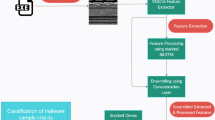Abstract
Due to different malware and their variants appear every year, it is difficult to identify the virus. In traditional malware analysis methods, both static analysis methods and dynamic analysis methods may be limited due to related detection methods. The rise of artificial intelligence has allowed the classification of malware to be detected by artificial intelligence. Therefore, this paper uses artificial intelligence to create a classification model for malware images. We first use Discrete Cosine Transform (DCT) and Discrete Wavelet Transform (DWT) to further feature extraction of the visualized malware image, and use Generative Adversarial Network (GAN) to generate malware of the same family, which can increase the number of samples. Finally, a convolutional neural network (CNN) is used to create a classification model of malware images to achieve the purpose of classifying malware. The results show that the accuracy of the classification results after discrete cosine transform (DCT) can reach 99.46%. After the discrete wavelet transform (DWT), the accuracy of the classification results can reach up to 99.84%.
Access this chapter
Tax calculation will be finalised at checkout
Purchases are for personal use only
Similar content being viewed by others
References
Nataraj, L., Karthikeyan, S., Jacob, G., Manjunath, B.S.: Malware images: visualization and automatic classification. In: Proceedings of the 8th International Symposium on Visualization for Cyber Security, pp. 1–7 (2011)
Kosmidis, K., Kalloniatis, C.: Machine learning and images for malware detection and classification. In: Proceedings of the 21st Pan-Hellenic Conference on Informatics, pp. 1–6 (2017)
Zolkipli, M.F., Jantan, A.: A framework for malware detection using combination technique and signature generation. In: 2010 Second International Conference on Computer Research and Development, pp. 196–199 (2010)
Wu, L., Zhang, Y.: Automatic detection model of malware signature for anti-virus cloud computing. In: 2011 10th IEEE/ACIS International Conference on Computer and Information Science, pp. 73–75 (2011)
Yan, H., Zhou, H., Zhang, H.: Automatic malware classification via PRICoLBP. Chin. J. Electron. 27, 852–859 (2018)
Siddiqui, M., Wang, M.C., Lee, J.: Detecting Trojans using data mining techniques. In: International Multi Topic Conference, pp. 400–411 (2008)
Carlin, D., Cowan, A., O’kane, P., Sezer, S.: The effects of traditional anti-virus labels on malware detection using dynamic runtime opcodes. IEEE Access 5, 17742–17752 (2017)
Long, A., Saxe, J., Gove, R.: Detecting malware samples with similar image sets. In: Proceedings of the Eleventh Workshop on Visualization for Cyber Security, pp. 88–95 (2014)
Du, D., Sun, Y., Ma, Y., Xiao, F.: A novel approach to detect malware variants based on classified behaviors. IEEE Access 7, 81770–81782 (2019)
Wadkar, M., Di Troia, F., Stamp, M.: Detecting malware evolution using support vector machines. Expert Syst. Appl. 143, 113022 (2020)
Han, K., Kang, B., Im, E.G.: Malware analysis using visualized image matrices. Sci World J 132713, 1–15 (2014)
Kalash, M., Rochan, M., Mohammed, N., Bruce, N.D., Wang, Y., Iqbal, F.: Malware classification with deep convolutional neural networks. In: 2018 9th IFIP International Conference on New Technologies, Mobility and Security (NTMS), pp. 1–5 (2018)
Author information
Authors and Affiliations
Corresponding author
Editor information
Editors and Affiliations
Rights and permissions
Copyright information
© 2023 The Author(s), under exclusive license to Springer Nature Switzerland AG
About this paper
Cite this paper
Kuo, WC., Chen, YT., Huang, YC., Wang, CC. (2023). Malware Detection Based on Image Conversion. In: Tsihrintzis, G.A., Wang, SJ., Lin, IC. (eds) 2021 International Conference on Security and Information Technologies with AI, Internet Computing and Big-data Applications. Smart Innovation, Systems and Technologies, vol 314. Springer, Cham. https://doi.org/10.1007/978-3-031-05491-4_19
Download citation
DOI: https://doi.org/10.1007/978-3-031-05491-4_19
Published:
Publisher Name: Springer, Cham
Print ISBN: 978-3-031-05490-7
Online ISBN: 978-3-031-05491-4
eBook Packages: Intelligent Technologies and RoboticsIntelligent Technologies and Robotics (R0)




